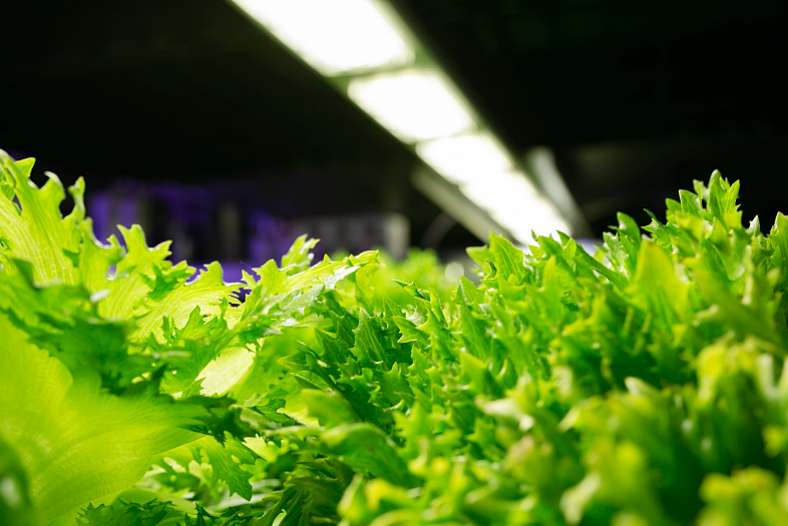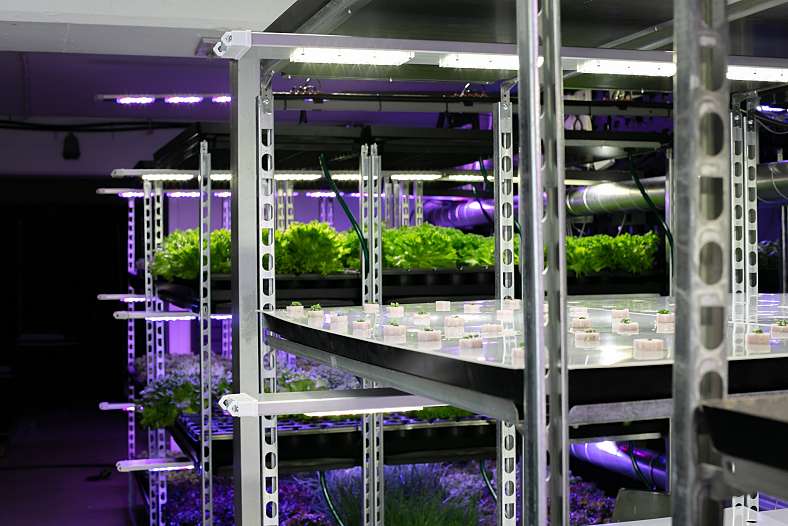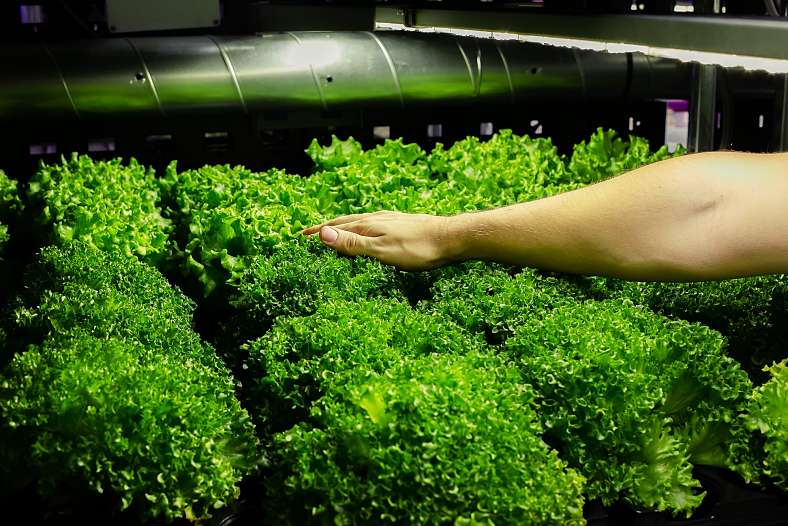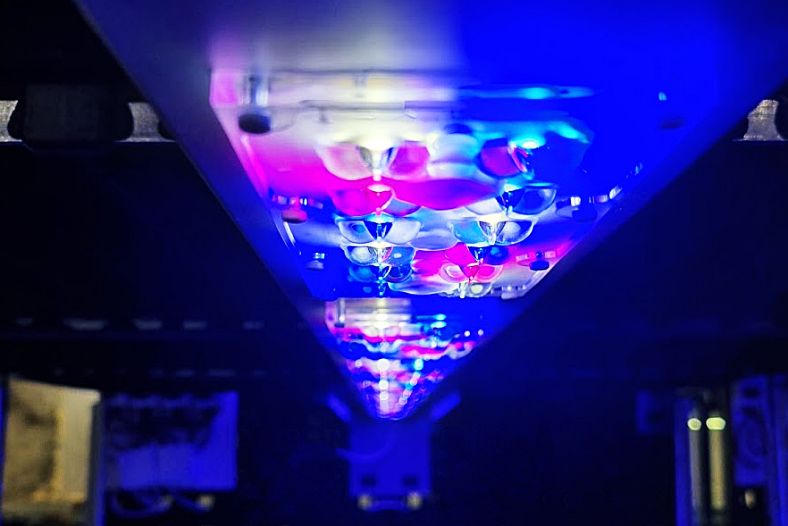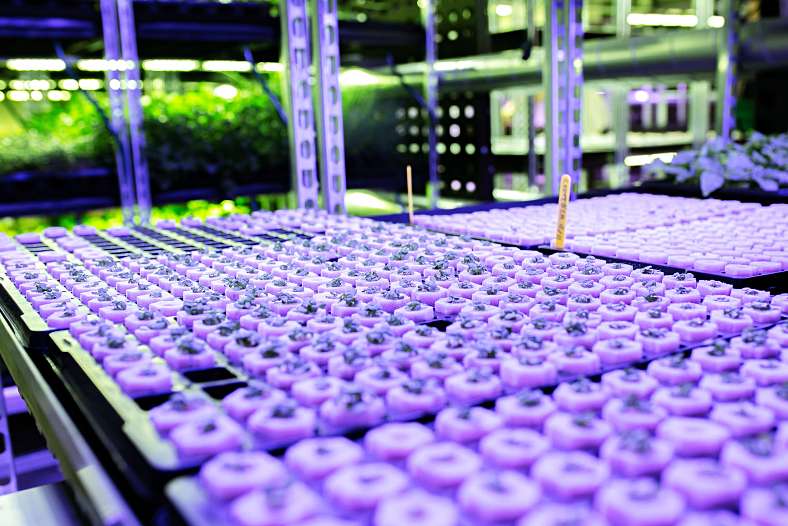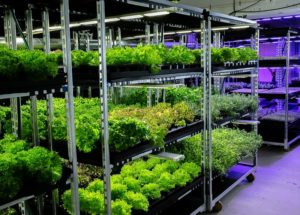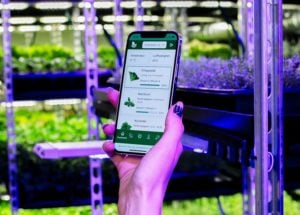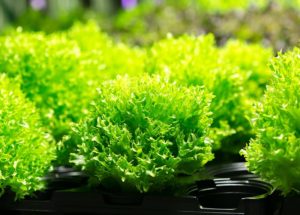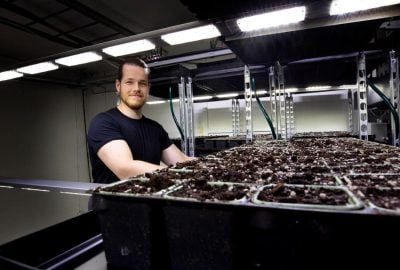Indoor farming has come to the point where it outclasses conventional farming, and it’s all thanks to LED grow lights. Not only does LED grow lights yield tastier and healthier plants; but Recent LED technology also reduces resources and doubles production speed, which makes plant growth more profitable than ever before.
It might sound strange, but LED grow lights outclass sunlight when it comes to plant growth.
Related article: Vertical farming costs: Maximize plant factory ROI
LED Grow Lights Benefits
In short, there are two main reasons why LED grow lights outclass all other light sources. For one, it makes much more efficient use of electricity, and secondly, it allows for better plant growth control than any other light source.
Modern agricultural science tells us that different wavelengths of light affect different stages of plant growth cycles. What does this mean? Well, light is a combination of different colors, and each color has a different wavelength. This gives the different colors unique properties which affect plant growth in specific ways.
LED grow lights let you control and manipulate the color spectrum so that your plants get the best light conditions at all stages of development.
Why LED grow lights are awesome!
The superior control of LED grow lights enables indoor farmers to adjust the taste, look, and even nutritional values of their plants with unparalleled accuracy.
Not only that but LED grow lights make vertical agriculture incredibly predictable. Perfected plant growth formulas are easy to duplicate. You can also replicate them faster than traditional farming allows. Indoor farming might have gotten a bad rep due to the inefficient grow light technology of the past, but those days are over.
So far, HPS (High-Pressure Sodium) and MH (Metal Halide) grow lights have been widespread in indoor farming but LED grow lights outmatch their technology on all accounts. LED grow lights take vertical farming into the future. They bring down costs, raise the bar for plant quality, and turn indoor farming into a viable industry.
Related article: Why invest in vertical farming?
We’ll get into why LED grow lights are better than sunlight, HPS, and MH in a minute, but first, let us outline the contents of this article:
- How do color wavelengths affect plant growth?
- What are Lumen, Lux, PAR, and PPFD, and how do they affect plant growth?
- Why are LED grow lights better for plant cultivation?
- LED grow lights Vs HPS/MH grow lights
- Conclusion | Starting your plant growth 2.0
How do color wavelengths affect plant growth?
The main properties of the different colors/wavelengths can be broken down as follows: White light has the shortest wavelength, which also makes it the most intense light. Blue light has a medium wavelength, while red is on the opposite end of the spectrum, with the longest wavelength.
White light is often referred to as ultraviolet light or UV light. In fact, they are two different things, but they often operate in tandem. White light is light that is visible to the human eye. UV-light is not. White light from LED grow lights is accompanied by UV rays. These rays can be used to the benefit of plant growth, but too large doses can be harmful.
Somtimes, plants get sunburnt from UV rays, just like humans. LED grow lights allow us to carefully adjust the different wavelengths, which also means that we can easily avoid hurting our plants with too much light. The result is radically improved efficiency in plant growth.
Agricultural science tells us that red and blue lights are most important for plant growth. This is why vertical farms most often bathe their plants in these colors. White light is also important, but more often than not, strong white light such as sunlight will inhibit plant growth. The exceptions are plants like cucumber, tomatoes, and sweet potatoes, which thrive in direct sunlight.
Related article: Vertical farm plants: What can you grow?
Indoor grow light conditions
However, most of the plants that are grown on indoor farms prefer limited amounts of white light. Salads, kale, herbs, and microgreens grow much better in blue and red lights.
Blue light, for instance, affects the appearance of your plant growth. The reason for this is that plants depend on the wavelengths of blue light to develop chlorophyll. When plants are fed ample amounts of blue light they become lush, with strong stems and vigorous leaves.
Red light, on the other hand, is important for sprouting and fruit or flower development. This is because plants need red light to start their photosynthesis. Without going into detail about the chemical processes, let’s end this section by telling you that chlorophyll strongly absorbs red light, and therefore is key for efficient photosynthesis.
In other words, a good balance between blue and red lights is essential for optimized plant growth. Too much red light will result in thinning plant growth, while too much blue light will end plant growth prematurely and prevent your plants from reaching their full potential. Well-configured plant recipes will adjust the lighting conditions perfectly and ensure optimized plant growth.
Total control over lighting conditions requires good measurement tools. In agricultural science, a wide range of units are used to measure and describe the different properties of various light sources. These measurements are necessary to ensure optimal plant growth. The most common unit for measuring light is Lumens, but in the context of plant growth, it is not very useful.
Related article: How to make a vertical farm with ideal conditions for plant growth?
What are Lumen, Lux, PAR, and PPF, and how do they affect plant growth?
The most common units for measuring light are “Lumens” and “Lux”. When it comes to plant growth, however, other measuring units are more suitable. An especially important unit for indoor farmers is called PAR (Photosynthetic Active Radiation Spectrum).
What is the difference between Lumens, Lux, and PAR? In simple terms, lumen and lux measure light conditions that are visible to the human eye. Lumen is a measurement of how much light a light source emits. Lux tells us how intense the light is when hitting or passing through a surface. PAR tells us which wavelengths the plants need at each stage in their growth cycle to maintain optimal photosynthesis.
At this point, we should underline that PAR is not actually a unit of measure, but rather a tool for identifying which light waves are most beneficial for your plant growth. Once you have determined whether the plant needs blue or red light, for instance, the amount of the PAR wavelength can be measured and adjusted with another tool called PPF (Photosynthetic Photon Flux).
Takeaway about light measuring units
To recap and elaborate on the previous paragraph, both PAR and PPF are tools. PPF measures the amount of PAR. The unit of measure is “micromoles per second”. To not lose ourselves in agricultural nomenclature, we’ll stop at micromoles, which simply put is a measurement for substance quantities.
The takeaway to keep in mind is that PAR and PPF are more important tools for efficient plant growth than Lumens. Lux is useful, since it determines the distance between your grow lights and plants. However, it doesn’t say anything about plant conditions.
What you need to know is that PPF lets you adjust lighting conditions for plant growth. It enables us to balance the red and blue light particles (photons) that hit our plants. The better balance we adjust, the more efficient the photosynthesis will be, which directly connects to efficient plant growth.
Related article: What is VPD / RH? Vertical farming’s hidden success factors!
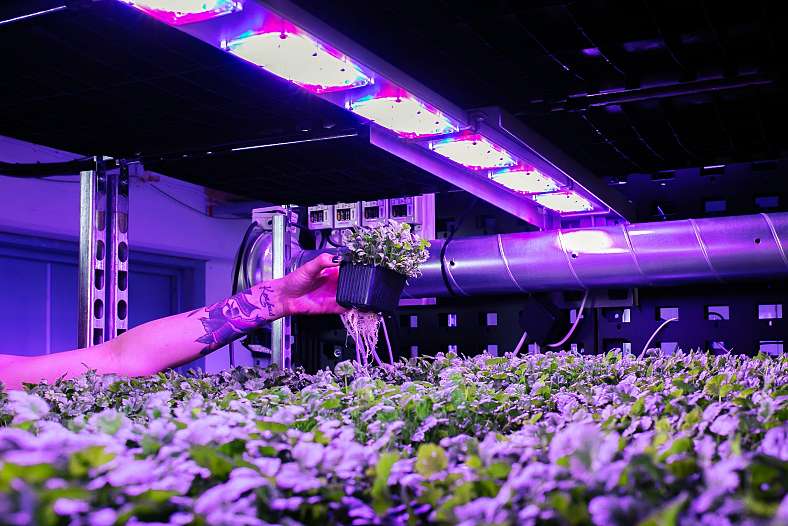
Why are LED grow lights better for plant cultivation?
LED grow lights are specifically designed for indoor farming. Recent LED technology keeps the energy consumption incredibly low. Frankly, LED has overtaken all other grow lights and operates in a league of its own.
Other grow lights might cover a wider range of wavelengths, but LED is advantageous since it eliminates all wavelengths except the ones that are useful for plant growth. In addition, the lifespan of LED grow lights is many times longer than other grow lights (the sun excluded of course).
Avisomo’s grow lights emit wavelengths of red, blue, and white. This combination allows for efficient adjustment in accordance with growth cycles. Our LED grow lights let you regulate and optimize your plant growth conditions with high accuracy.
Check out Avisomo’s vertical farming solutions to see all components needed for vertical farming.
LED accuracy is key
Compared to other grow lights for indoor farming, like HPS for instance, LED grow lights will cut your energy consumption in half when used correctly. The reason for this is that LED grow lights are very flexible, especially when it comes to light dimming. This is an important factor because plants in indoor farming require less light when they grow taller and stretch closer to the light source.
LED grow lights cost more to buy per lamp, but when we factor in the lifespan of LED lamps, the price is actually a lot cheaper. Most manufacturers of LED grow lights guarantee 50.000 to 100.000 hours of use, depending on the construction of the lamp and how hot it gets on a daily basis.
Avisomo grow lights come with some of the best cooling technology available on the market today. Even after 24 hours of use, you can easily hold the lamp in the palm of your hand without hurting yourself.
Cold grow lights means that the heat is spreading well throughout the components that the lamps are made of. This promotes a long lifespan since cool components are less prone to wear and tear. Avisomo offers a five-year guarantee on all grow lights, but the expected lifespan is in fact twenty years. Should a diode in the LED grow light fail, our service agreement includes replacement lamps with no extra cost.
LED grow lights Vs HPS/MH grow lights
The LED grow lights of today are 100 percent more efficient than HPS and MH lamps. As already mentioned, LED allows for better dimming than HPS and MH, but this is only part of the reason for their effectiveness. Superior distribution of heat also means that LED grow lights develop more light with less Watt used.
In a nutshell, LED is more cost-efficient because they are cheaper to buy. They deliver more light, use less energy, make better conditions, which results in optimized plant growth. In theory, vertical farms can produce twice as much per year as conventional farms, and they owe it all to LED technology.
Sounds too good to be true?! Well, let’s get bone dry for a moment and consider the math.
Watts & Dollars
You might remember that we talked about micromoles in the chapter about measuring units? Now, we can further inform you that LED grow lights produce 3.2 micromoles per second per Watt, while HPS lamps produce 1.8 micromoles per second per watt.
In other words, Avisomo LED grow lights produce 3.2 micromoles per watt. This means that one single lamp (which covers roughly 2.7 km2 and is turned on 18 hours a day) consumes about 1.2 MW (Megawatts) per year. In terms of Norwegian energy prices, this means that the energy cost of one lamp per year is ca. 2000 NOK.
HPS grow lights double the energy consumption under the same conditions. This means that in order to produce the same number of micromoles, HPS lamps will consume 2.4 MW, with an energy cost of 4000 NOK per year per lamp. On top of that comes worsened growth conditions, since HPS grow lights get a lot hotter and demand more cooling.
Because LED grow lights consume less Watts, they also produce less heat than HPS and MH lamps. In addition, LED grow lights are designed to spread the heat throughout the lamp’s material. HPS, on the other hand, radiates copious amounts of heat directly at your plant growth.
LED lifespan alters the equation
To finish our equation, we need to factor in lamp lifespan. Retail value on HPS grow lights in relation to energy consumption comes out at a practical cost of roughly 3.2 NOK per Watt. LED grow lights end up costing almost three times as much, about 12 NOK per Watt. This might not look so good, but we must not forget that LED grow lights guarantee at least 50.000 hours of use.
HPS grow lights must be changed every 10.000 hours to keep plant growth optimal. This means that you will go through five HPS grow lights before you even need to think about changing your LED grow lights.
Stay with us now! Here comes the most complicated part, but also the kicker!
Maintenance cost including work hours ends up costing about 1 NOK per Watt when using HPS grow lights. This means that it costs 1 NOK to produce 1.8 micromoles. In addition, we know that 1 Watt gives us 1.8 micromoles when using HPS, but it gives us 3.2 micromoles when using LED. This means that LED consumes 1 Watt and HPS 1.8 Watt to produce the same amount of light.
When putting these numbers into a maintenance equation we realize that 50.000 hours of use + maintenance of HPS grow lights ends up costing us 45 NOK
5 NOK + 0,8 W x 50.000/1000 = 45 NOK
LED grow lights does not require maintenance. However, the price per watt is still 12 NOK, which is considerably more HPS’ 3.2 NOK. Still, this leads us to the following total costs for LED and HPS:
HPS grow lights 50.000 hours use: 48.2 NOK per Watt
LED grow lights 50.000 hours use: 12 NOK per Watt
Not a big fan of math? Don’t hesitate to contact Avisomo. We’ll help you calculate costs and budgets.

Conclusion | Starting your plant growth 2.0
Intricate equations aside, the latest developments in LED technology are the solution for all indoor farmers who have been struggling to make ends meet. Next-gen indoor farms have arrived. Their vegetables are tastier, prettier, more nutrient-packed, and their business model is more competitive than ever before. LED grow lights were the key. They radically lowered costs, drastically increased growth quality, and made all kinds of indoor farming a safe investment for the future.
Related article: The best vertical plant factory solutions right now!
Resources
Gardening Know-How: Red Light vs. Blue Light: Which Light Color Is Better For Plant Growth
Greenhouse Today: Does The Color Of Light Affect Plant Growth
GroWell: Light Measurement: Lumens, Lux, PAR And Micromoles
Institutt for biovitenskap ved Universitet i Oslo: Fotosyntesens effektivitet
Institutt for biovitenskap ved Universitet i Oslo: Lyskompensasjonspunkt
Thule Scientific: On the Solar Spectrum and the Color Sensitivity of the Eye




